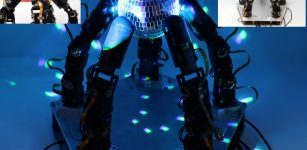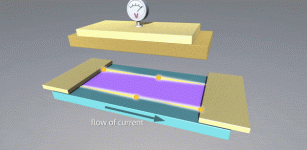Insect-Sized Flying Robots With Flapping Wings – New Achievement Of Bristol Scientists
Eddie Gonzales Jr. – MessageToEagle.com – A new drive system for flapping wing autonomous robots has been developed by a University of Bristol team, using a new method of electromechanical zipping that does away with the need for conventional motors and gears.
Front view of the flying robot. Image credit: Dr. Tim Helps
This new advance, published today in the journal Science Robotics, could pave the way for smaller, lighter, and more effective micro flying robots for environmental monitoring, search and rescue, and deployment in hazardous environments.
Until now, typical micro flying robots have used motors, gears, and other complex transmission systems to achieve the up-and-down motion of the wings. This has added complexity, weight, and undesired dynamic effects.
Taking inspiration from bees and other flying insects, researchers from Bristol’s Faculty of Engineering, led by Professor of Robotics Jonathan Rossiter, have successfully demonstrated a direct-drive artificial muscle system, called the Liquid-amplified Zipping Actuator (LAZA), that achieves wing motion using no rotating parts or gears.
The LAZA system greatly simplifies the flapping mechanism, enabling future miniaturization of flapping robots down to the size of insects.
They also demonstrated how the LAZA can deliver consistent flapping over more than one million cycles, important for making flapping robots that can undertake long-haul flights.
The team expects the LAZA to be adopted as a fundamental building block for a range of autonomous insect-like flying robots.
Dr. Tim Helps, lead author and developer of the LAZA system said: “With the LAZA, we apply electrostatic forces directly on the wing, rather than through a complex, inefficient transmission system.
This leads to better performance, simpler design, and will unlock a new class of low-cost, lightweight flapping micro-air vehicles for future applications, like autonomous inspection of offshore wind turbines.”
Professor Rossiter added: “Making smaller and better performing flapping-wing microrobots is a huge challenge.
LAZA is an important step toward autonomous flying robots that could be as small as insects and perform environmentally critical tasks such as plant pollination and exciting emerging roles such as finding people in collapsed buildings.”
Written by Eddie Gonzales Jr. – MessageToEagle.com Staff
Related Posts
-
 Smallest Walking Robot In Action
No Comments | Dec 3, 2024
Smallest Walking Robot In Action
No Comments | Dec 3, 2024 -
 Can Virtual Reality Save The Planet?
No Comments | Aug 19, 2021
Can Virtual Reality Save The Planet?
No Comments | Aug 19, 2021 -
 Optimizing Phase Change Materials Could Reduce Power Plant Water Consumption
No Comments | Jul 29, 2021
Optimizing Phase Change Materials Could Reduce Power Plant Water Consumption
No Comments | Jul 29, 2021 -
 Robot Operates In The Dark And Relies On Sense Of Touch And Not On Vision – Columbia Engineers’ Design
No Comments | Apr 28, 2023
Robot Operates In The Dark And Relies On Sense Of Touch And Not On Vision – Columbia Engineers’ Design
No Comments | Apr 28, 2023 -
 From Seawater To Drinking Water, With The Push Of A Button
No Comments | May 9, 2022
From Seawater To Drinking Water, With The Push Of A Button
No Comments | May 9, 2022 -
 A Look Into The Future: Can Planet Earth Support 10 Billion People?
No Comments | Jul 21, 2015
A Look Into The Future: Can Planet Earth Support 10 Billion People?
No Comments | Jul 21, 2015 -
 High-Performance Batteries For Transporting Mobility Into The Future
No Comments | Sep 7, 2021
High-Performance Batteries For Transporting Mobility Into The Future
No Comments | Sep 7, 2021 -
 New Imaging System Captures Text From Barely Open Books
No Comments | Oct 26, 2021
New Imaging System Captures Text From Barely Open Books
No Comments | Oct 26, 2021 -
 Is It Possible To Transmit Messages And Speech Through The Skin? – Researchers Have A Method
No Comments | Sep 13, 2018
Is It Possible To Transmit Messages And Speech Through The Skin? – Researchers Have A Method
No Comments | Sep 13, 2018 -
 A ‘Sandwich’ Out Of Magnets And Topological Insulators Potential For Lossless Electronics
No Comments | Apr 5, 2022
A ‘Sandwich’ Out Of Magnets And Topological Insulators Potential For Lossless Electronics
No Comments | Apr 5, 2022

